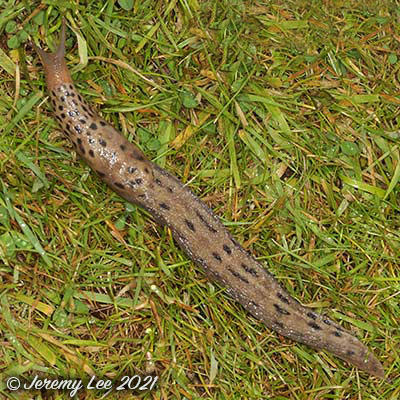
 |
|
Scientific Classifications explained » Amphibians » Ants » Aphids » Bees » Beetles » Birds » Bugs » Butterflies » Caterpillars » Damselflies » Dragonflies » Earwigs » Flies » Frog/Leafhoppers » Fungi » Galls » Grasshoppers » Harvestmen » Hoverflies » Lacewings » Ladybirds » Leaf Mines » Lichens » Mammals » Millipedes » Mosses » Moths » Sawflies » Slugs » Snails » Spiders » Trees & Shrubs » Wasps » Wild Flowers » Woodlice » Postboxes |
UK Nature > Slugs > Limax maximus

Scientific Name: Limax maximus Common Name: Leopard Slug Limax maximus, or the Leopard Slug as it is more commonly known, is usually strikingly marked but quite variable. This is one of the largest British slugs, reaching up to 150 mm. Spots on the back are usually oriented in three longitudinal bands. Some specimens, mainly found in woodland, lack most spots and are pale brown. The sole is ash coloured and the mucus is colourless and not very sticky. In general, leopard slugs are active at night, though they may also be seen in daytime during wet, warm and overcast weather. Usually they sleep under stones, rubble, deadwood, such as tree trunks and shelves, as well as in dark wall crevices. They emerge to feed, and then can be found on mushrooms, withered plants and on algae growing on trees and stones. Limax maximus is a partial carnivore that also feeds on carrion, but also on other slugs and their eggs. Leopard slugs have even been observed to lead to a decrease of harmful slug species. So even if Limax maximus sometimes feeds on garden plants, it should not be called a garden pest, which it can only be in great numbers of overpopulation. |
|

https://www.uknature.co.uk is a website dedicated to showing the immense diversity of UK nature and wildlife. Our vast range of habitats, from lowland arable to snow covered mountains, from storm-ravaged coastlines to peaceful inland freshwater lakes and rivers, from dry, sandy heaths to deciduous and coniferous forests, all these habitats contribute to the abundance of UK nature. We have wild birds in huge numbers either residing or visiting our shores (597 recorded species as at July 2013) and we must also not forget the humble back garden with its grass lawns, flower beds filled with nectar rich flowers, shrubs and trees, all designed to attract huge numbers of insects such as bees, moths, butterflies and hoverflies; and finally the small ponds which provide safe havens for frogs, toads, newts and even slow worms and grass snakes. www.uknature.co.uk is the showcase for my personal passion, photographing uknature in all its glory. I sincerely hope you all enjoy the fruits of my labours. This site and all images contained therein is © Jeremy Lee 2004 - 2025. All Rights Reserved. Site design by Jeremy Lee. Site development & IT Support by Stuart Lee. |